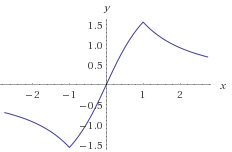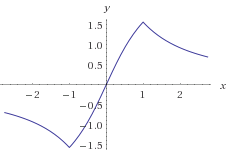I don't know the answer. Do you?
d x d [ arcsin ( 1 + x 2 2 x ) ] x = 1 = ?
This section requires Javascript.
You are seeing this because something didn't load right. We suggest you, (a) try
refreshing the page, (b) enabling javascript if it is disabled on your browser and,
finally, (c)
loading the
non-javascript version of this page
. We're sorry about the hassle.
2 solutions
Moderator note:
Your first explanation doesn't work. You are assuming that the derivative of a function must be continuous, which is not necessarily true. There isn't a reason to evaluate lim x → 1 f ′ ( x ) in order to determine if f ′ ( 1 ) exists.
Instead, what we have is that f ′ ( 1 ) = lim x → 1 x − 1 f ( x ) − f ( 1 ) . It is this limit where the left-hand limit and the right-hand limit are different, which is why f ′ ( 1 ) doesn't exist.
The second and third explanations work, because they are considering lim x → 1 x − 1 f ( x ) − f ( 1 )
@Calvin Lin , Yes, I thought this same thing at school today... And now you said it! Thanks Sir!
So, if we take f ′ ( 1 ) = x → 1 lim x − 1 f ( x ) − f ( 1 ) , what we get is method 3 right? So can I delete method 1 (which is wrong)?
Log in to reply
Actually, looking at method 3 again, it doesn't work for the same reason. What you are calculating is lim x → 1 f ′ ( x ) , which may not be equal to f ′ ( 1 ) .
And of course, method 2 via "inspection of graph" isn't a proof per se.
Log in to reply
I can correct the third method. But correcting the first method brings me to the corrected 3rd one...
Are you able to figure out why the derivative of a differentiable function need not be continuous? If so, please add a solution
Log in to reply
Yes! I will add a solution. Had tests these days. I'll post a solution today. Sorry for the delay...
I think that should do it @Calvin Lin sir...
GENERAL MISTAKE:
Take x = tan θ ⟺ θ = arctan x .
So, arcsin ( 1 + x 2 2 x ) = arcsin ( 1 + tan 2 θ 2 tan θ ) = arcsin ( sin 2 θ ) = 2 θ = 2 arctan x
d x d arcsin ( 1 + x 2 2 x ) = d x d 2 arctan x = 1 + x 2 2
Therefore,
d x d [ arcsin ( 1 + x 2 2 x ) ] x = 1 = 1
But this is actually W R O N G .
CORRECT METHOD:
Let us see what happens if we bash this problem directly.
Let f ( x ) = arcsin ( 1 + x 2 2 x )
f ′ ( x ) = d x d [ arcsin ( 1 + x 2 2 x ) ] = 1 − ( 1 + x 2 2 x ) 2 1 × d x d ( 1 + x 2 2 x ) = ∣ 1 − x 2 ∣ 1 + x 2 × ( 1 + x 2 ) 2 2 ( 1 − x 2 )
What actually this says?? This says that the derivative of f ( x ) does not exist at x = 1 .
Be careful while calculating the derivatives using substitution method.
Moderator note:
Interesting question. Unfortunately, your analysis has several holes.
-
In General mistake , you mistakenly claim that a r c s i n ( sin 2 θ ) = 2 θ . See Inverse Trig puzzle for why this is not true. This explains why you obtained an incorrect answer using this method.
-
Derivative using substitution method x = g ( θ ) is valid, as long as the substitution used is a differentiable function in the neighborhood, and g ′ ( θ ) = 0 . This follows from the chain rule:
g ′ ( θ ) f ∘ g ( θ ) = f ′ ∘ g ( θ ) )
-
The continuity of f ′ ( x ) at x = 1 is irrelevant to the existence of f ′ ( 1 ) . You have not yet shown that f ′ ( 1 ) does not exist.
-
The correct way to approach this, would be to use first principles, and show that the left-hand limit is 1, and the right-hand limit is -1, which is why the function isn't differentiable at 1 since the limits are not equal.
Interesting question, but your analysis of the problem is flawed.
Log in to reply
is it possible to get a genralised result of differentiation of a factorial
Log in to reply
Jaswinder Singh there is general result of differentiation of factorials. Differentiation of gamma function. Γ a ( x ) = ∫ 0 ∞ ( t x − 1 ( l n t ) a e − t ) d t .
I think the limit exists because at x = 1 , arcsin ( sin 2 θ ) = 2 θ = 2 arctan x
sin − 1 ( 1 + x 2 2 x ) = ⎩ ⎪ ⎨ ⎪ ⎧ − π − 2 tan − 1 x 2 tan − 1 x π − 2 tan − 1 x x < − 1 x ∈ [ − 1 , 1 ] x > 1
See the graph

So, the answer will be 1.
Log in to reply
You drew the graph of sin − 1 1 + x 2 2 x

From this, we can conclude that the limit lim x → 1 sin − 1 1 + x 2 2 x exists and is equal to 2 π .
Furthermore, by looking at the slopes of the limiting tangents, the limit lim x → 1 d x d ( sin − 1 1 + x 2 2 x ) does not exist. From the LHS, the limit is 1. From the RHS, the limit is -1. Hence, the function isn't differentiable at x = 1 .
Log in to reply
@Calvin Lin – I get it, I get it. So, what shloud be the answer?? "Limit does not exist"??
Log in to reply
@Kishore S. Shenoy – I would simply go with "does not exist" or "the differential does not exist"
Can you post a solution to this problem? Thanks!
sir I don't agree with you, you are suppose to simplify the expression before substitution. and I don't think that |1-x| is the same as ((1-x)^2)^1/2 like wot u assumed
Little mistake. If a function is not differentiable at x = a doesn't mean it is not continious at that point, for example f ( x ) = ∣ x ∣ at x = 0
Let's take the expression right away, without making any confusion. We here use, f ( x ) = sin − 1 ( 1 + x 2 2 x ) = ⎩ ⎪ ⎨ ⎪ ⎧ − π − 2 tan − 1 x 2 tan − 1 x π − 2 tan − 1 x x < − 1 x ∈ [ − 1 , 1 ] x > 1
To say that the limit exists, f ′ ( a ) = x → a − lim x − a f ( x ) − f ( a ) = x → a lim x − a f ( x ) − f ( a ) = x → a + lim x − a f ( x ) − f ( a )
Now let's take left hand and right hand limits. x → 1 + lim x − 1 f ( x ) − f ( 1 ) Using L’H o ˆ pital’s rule x → 1 − lim x − 1 f ( x ) − f ( 1 ) Using L’H o ˆ pital’s rule ⇒ x → 1 + lim sin − 1 ( 1 + x 2 2 x ) = h → 0 + lim h f ( 1 + h ) − f ( 1 ) = h → 0 + lim h π − 2 tan − 1 ( 1 + h ) − 2 tan − 1 ( 1 ) = h → 0 + lim ( 1 + h ) 2 + 1 − 2 = − 1 = h → 0 − lim − h f ( 1 − h ) − f ( 1 ) = h → 0 − lim − h 2 tan − 1 ( 1 − h ) − 2 tan − 1 ( 1 ) = h → 0 − lim − 1 ⋅ [ ( 1 − h ) 2 + 1 ] − 2 = 1 = x → 1 − lim sin − 1 ( 1 + x 2 2 x )
Thus, it is not differentiable at x = 1 , nor at x = − 1
We can say this just by looking at the graph of sin − 1 ( 1 + x 2 2 x )
At x = 1 , the graph has a sharp edge and thus the function is not differentiable at x = 1